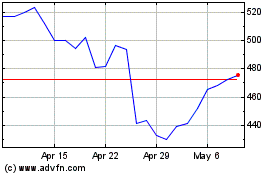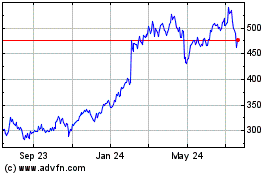EU Privacy Regulators Approve Data-Transfer Deal With U.S.
July 26 2016 - 8:50AM
Dow Jones News
BRUSSELS—European Union privacy regulators on Tuesday gave the
new EU-U.S. data-transfer deal their blessing despite some
lingering concerns, providing companies with more certainty though
legal challenges from privacy activists are likely.
The U.S. and the European Commission, the bloc's executive arm,
finalized the so-called Privacy Shield in mid-July, following
months of talks over the mechanism's technical details since it was
first announced in February.
The commission said it incorporated advice from the bloc's
national data-protection authorities and the European Parliament in
its final decision to ensure that Europeans' data is adequately
protected from American surveillance when moved to U.S.-based
servers.
On Tuesday, the head of the EU's regulators said the finalized
framework showed real improvements from the draft version and that
the data-protection authorities wouldn't challenge the new
framework in court on their own initiative.
"On several points, the final decision answers to what we asked
for, both on the commercial side and on the public-security side,"
said Isabelle Falque-Pierrotin, head of France's data-protection
authority and chairwoman of the pan-EU group.
The body representing the EU's national data-protection
authorities had warned in April it could challenge the Privacy
Shield in court unless both sides provided more clarity about bulk
collection of data by national-security services and other
issues.
The Privacy Shield replaces a previous mechanism, known as Safe
Harbor, which was struck down by the European Court of Justice on
concerns of mass surveillance by the U.S. The decision unleashed
uncertainty for thousands of companies relying on it to legally
send all types of business information, such as customer databases,
across the Atlantic.
While the new data-transfer framework will likely also be tested
in court by privacy activists demanding stricter controls about
access to data by U.S. intelligence services, the green light from
the privacy regulators for the new deal mitigates any uncertainty
for businesses planning to sign up.
Still, Ms. Pierrotin said the data-protection regulators had
some lingering concerns they hoped would be addressed in the first
annual review next summer. Under the new mechanism, authorities in
the U.S. and Europe will review the data-transfer framework every
year to ensure the smooth functioning of the Privacy Shield.
Ms. Pierrotin said, at that review, the privacy regulators want
to see evidence that the additional commitments by the U.S. over
limits to accessing Europeans data for security reasons are
effective.
She also suggested possible changes to U.S. legislation, such as
allowing the ombudswoman—currently Under Secretary of State
Catherine Novelli—to go before a judge if she is dissatisfied with
information provided by the oversight bodies. Under the Privacy
Shield, Ms. Novelli will be tasked with fielding and investigating
complaints from Europeans about U.S. surveillance practices.
While privacy regulators will give the Privacy Shield a chance
to get up and running, court decisions coming up before the annual
review could impact the regulatory landscape, Ms. Pierrotin
said.
In late May, the Irish Data Protection Commissioner's office
said it wanted the European Court of Justice, the EU's highest
court, to review backup contractual language that Facebook Inc. and
thousands of other companies use to justify sending personal
information about Europeans to the U.S.
Following last year's court decision, many companies are now
relying on contracts using those so-called standard contractual
clauses to authorize their data transfers.
The new measures secured for the Privacy Shield, such as
oversight from the ombudswoman as well as safeguards about limits
to access by national security services, also apply to those other
methods.
A negative court decision in the case over standardized
contracts could signify the Privacy Shield might also not pass a
test in court.
Companies can sign up to the Privacy Shield starting Aug. 1.
Write to Natalia Drozdiak at natalia.drozdiak@wsj.com
(END) Dow Jones Newswires
July 26, 2016 08:35 ET (12:35 GMT)
Copyright (c) 2016 Dow Jones & Company, Inc.
Meta Platforms (NASDAQ:META)
Historical Stock Chart
From Mar 2024 to Apr 2024

Meta Platforms (NASDAQ:META)
Historical Stock Chart
From Apr 2023 to Apr 2024
